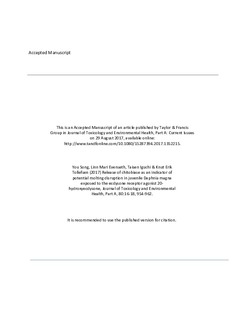| dc.contributor.author | Song, You | |
| dc.contributor.author | Evenseth, Linn Mari | |
| dc.contributor.author | Iguchi, Taisen | |
| dc.contributor.author | Tollefsen, Knut Erik | |
| dc.date.accessioned | 2018-10-05T08:58:58Z | |
| dc.date.available | 2018-10-05T08:58:58Z | |
| dc.date.created | 2017-11-26T12:18:00Z | |
| dc.date.issued | 2017 | |
| dc.identifier.citation | Journal of Toxicology and Environmental Health, Part A. 2017, 80 (16-18), 954-962. | nb_NO |
| dc.identifier.issn | 1528-7394 | |
| dc.identifier.uri | http://hdl.handle.net/11250/2566608 | |
| dc.description.abstract | During arthropod molting, the old exoskeleton is degraded and recycled by the molting fluid. Chitobiase, a major chitinolytic enzyme in the molting fluid, has been widely used as a biomarker to indicate endocrine disruption of molting in arthropods under environmental stress. Although release of chitobiase was extensively studied in organisms exposed to molting-inhibiting chemicals, enzymic association with molting and response of the molting hormone receptor, ecdysone receptor (EcR), is not well understood. The present study was therefore conducted to identify potential linkages between release of chitobiase, molting frequency, and EcR activation in a freshwater crustacean Daphnia magna after short-term (96 hr) exposure to endogenous molting hormone 20-hydroxyecdysone (20E). A suite of bioassays was used for this purpose, including the chitobiase activity, molting frequency, viability, and in vitro EcR activation. Effect concentrations were compared between different assays analyzed. Results showed that exposure to 20E reduced chitobiase release and molting frequency in a concentration-dependent manner. Exposure to as low as 250 nM 20E significantly decreased release of chitobiase after 72 hr exposure, whereas adverse effects on molting frequency and incomplete molting-associated mortality required higher 20E exposure concentrations. The EcR reporter assay further demonstrated that as low as 100 nM 20E may activate EcR in vitro. Data suggest that release of chitobiase may be employed as a sensitive indicator of potential molting disruption in crustaceans after exposure to EcR agonists such as 20E. | nb_NO |
| dc.language.iso | eng | nb_NO |
| dc.publisher | Taylor & Francis | nb_NO |
| dc.title | Release of chitobiase as an indicator of potential molting disruption in juvenile Daphnia magna exposed to the ecdysone receptor agonist 20-hydroxyecdysone | nb_NO |
| dc.type | Journal article | nb_NO |
| dc.type | Peer reviewed | nb_NO |
| dc.description.version | acceptedVersion | nb_NO |
| dc.source.pagenumber | 954-962 | nb_NO |
| dc.source.volume | 80 | nb_NO |
| dc.source.journal | Journal of Toxicology and Environmental Health, Part A | nb_NO |
| dc.source.issue | 16-18 | nb_NO |
| dc.identifier.doi | 10.1080/15287394.2017.1352215 | |
| dc.identifier.cristin | 1518460 | |
| dc.relation.project | Norges forskningsråd: 221455 | nb_NO |
| cristin.unitcode | 7464,20,13,0 | |
| cristin.unitname | Økotoksikologi | |
| cristin.ispublished | true | |
| cristin.fulltext | original | |
| cristin.fulltext | postprint | |
| cristin.qualitycode | 1 | |
